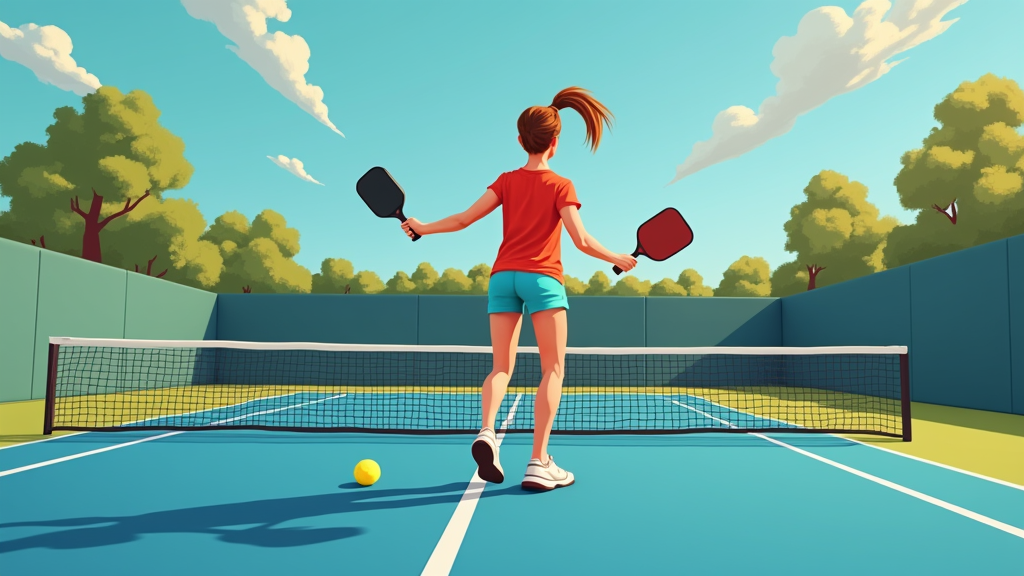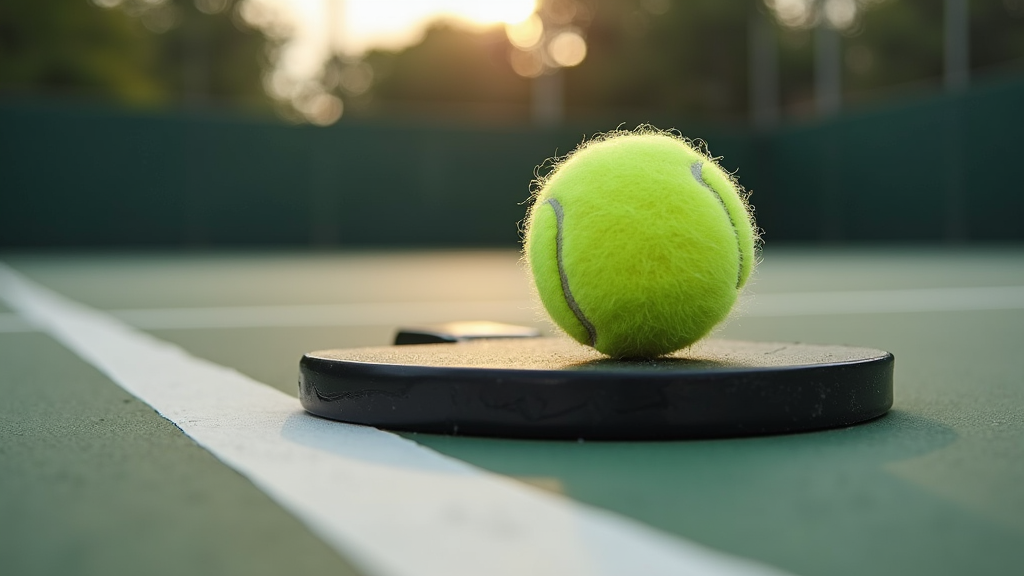Table of Contents
- Introduction to USA Pickleball
- The Origins and Evolution of USA Pickleball
- Gameplay and Rules
- USA Pickleball Championships
- 2025 Rule Changes and Updates
- Spectator Line Calls (Rule 6. C.4.)
- Rally Scoring (Provisional Rules 4. G.1. and 12. B.1.)
- Not Ready Signals (Rule 4. C.2.)
- Definition of a Volley (Rules 9. B.1 and 9. H)
- Calling a Fault (Rules 13. D.1.c and 7. O.)
- Calling a Fault on a Partner (Rule 13. D.1.a.)
- Paddle Autographs (Rule 2. E.5.c.)
- Paddle Regulations (Appendix 8.)
- Serving Changes (Rule 4. A.5.)
- Server Positioning (Rule 3. A.38.)
- The Future of Pickleball
- Conclusion
Introduction to USA Pickleball

The Rise of a National Sport
Pickleball isn’t just a sport; it’s a phenomenon sweeping the nation. With over 13.6 million players by 2023, it’s clear that pickleball has moved beyond a simple pastime to become a significant part of the American sporting landscape. Its appeal spans generations, attracting players of all ages and skill levels to the courts.
The sport’s popularity has surged so dramatically that it was officially recognized as the state sport of Washington in 2022. This recognition underscores pickleball’s deep roots in the Pacific Northwest and its growing importance nationwide.
From 2021 to 2023, pickleball earned the title of the fastest-growing sport in the US. This explosive growth highlights its accessibility, social nature, and the sheer fun that players experience on the court. Whether you’re a seasoned athlete or a complete beginner, pickleball offers an engaging and rewarding experience.
Historical Roots
The story of pickleball begins in the summer of 1965 on Bainbridge Island, Washington. Faced with bored children and a lack of entertainment, Joel Pritchard, Barney McCallum, and Bill Bell improvised a new game using a Wiffle ball, ping-pong paddles, and a badminton net.
What started as a makeshift activity quickly evolved into a unique sport with its own set of rules and strategies. The founders named their creation “pickleball,” though the exact origin of the name remains a subject of debate. Some say it was named after the Pritchard family dog, Pickles, who had a habit of chasing after the ball. Others claim the name came from the term “pickle boat,” referring to a boat crewed by leftover oarsmen.
What You’ll Discover
In this blog post, we’ll dive deep into the world of USA Pickleball. Whether you’re a seasoned player or new to the game, there’s always something to learn and discover. We will cover:
- The history and evolution of USA Pickleball, from its humble beginnings to its current status as a national sensation.
- Key rules and gameplay aspects, providing you with a comprehensive understanding of how the game is played.
- Recent updates and changes for 2025, ensuring you stay informed about the latest developments in the sport.
So, grab your paddle and get ready to explore the exciting world of USA Pickleball!
The Origins and Evolution of USA Pickleball
Founding and Early Years
USA Pickleball, the governing body for the sport in the United States, has a rich history rooted in the dedication of a few passionate individuals. Established in 1984 as the United States Amateur Pickleball Association, its initial purpose was to foster the growth and advancement of pickleball across the nation.
The organization was founded by Bryon Olson, Sid Williams, and a group of other enthusiastic pickleball players in Tacoma, Washington. These individuals recognized the potential of this burgeoning sport and sought to create a structure that would support its development and ensure its accessibility to players of all levels.
Name Changes and Milestones
Over the years, the organization has undergone several transformations to better reflect its mission and scope. In 2005, the United States Amateur Pickleball Association transitioned to the USA Pickleball Association (USAPA), a move that signified its growing influence and professionalization. Further solidifying its brand, the organization rebranded as simply USA Pickleball in 2020.
USA Pickleball has achieved several significant milestones throughout its history. One notable event was the designation of President Ronald Reagan as the first honorary member. A pickleball set was even sent to the White House, further elevating the sport’s profile. Another key moment was the acquisition of the first sponsor, Nalley Fine Foods Company, which provided crucial financial support for exhibitions and the publication of rulebooks. In 1999, Frank Candelario took on the role of USAPA president, guiding the organization through a period of significant growth.
Organizational Structure
Since 2005, USA Pickleball has operated as a nonprofit 501(c)(3) organization, reinforcing its commitment to promoting the sport’s accessibility and development. This structure allows the organization to focus on its core mission without the pressures of profit-driven motives.
A cornerstone of USA Pickleball’s contribution to the sport is its role in establishing standardized rules and guidelines. In 1984, USAPA published the first official pickleball rule book, providing a consistent framework for gameplay. This was followed by the publication of the Official Tournament Rulebook in 2008, ensuring fair and consistent competition at all levels.
Gameplay and Rules

Basic Overview
Pickleball is a dynamic racket sport that can be enjoyed in singles or doubles format. The game involves players using a smooth-faced paddle to hit a perforated hollow plastic ball over a net that stands 34 inches high. One of the great things about pickleball is its versatility; it can be played both indoors and outdoors, making it accessible in various environments and weather conditions.
Court Dimensions and Zones
The pickleball court is a rectangle measuring 20 feet wide and 44 feet long, mirroring the dimensions of a badminton court. A crucial area of the court is the non-volley zone, often referred to as the “kitchen.” This zone extends 7 feet from the net on both sides.
The non-volley zone introduces a unique element to the game. Players are prohibited from volleying the ball (hitting it in the air) while standing within this zone. If a player is in the kitchen, they must wait for the ball to bounce before hitting it back over the net. This rule encourages strategic play and prevents players from dominating the net with continuous volleys.
Scoring System
Pickleball uses a side-out scoring system, which means that only the serving team can score points. A point is earned when the opposing team commits a fault. Common faults include hitting the ball out of bounds, failing to clear the net, volleying in the non-volley zone, or not serving properly.
The serving team continues to serve and score points until they commit a fault, at which point the serve is turned over to the opposing team. This scoring system adds an element of strategy, as teams must focus on minimizing errors and capitalizing on their opponents’ mistakes to gain an advantage.
Equipment Standards
To ensure fair play and consistent performance, pickleball paddles and balls must adhere to specific standards set by governing bodies. These standards regulate the size, weight, and material composition of the equipment.
For detailed specifications regarding paddle and ball measurements and weight limits, players and manufacturers should consult the official USA Pickleball rulebook. This resource provides comprehensive guidelines to ensure that all equipment used in sanctioned tournaments and recreational play meets the required standards.
USA Pickleball Championships
National Championships
The USA Pickleball National Championships stand as the pinnacle of competitive pickleball in the United States. This prestigious tournament is hosted annually at various locations, drawing top players from across the nation to compete for titles and recognition. In 2023, the championships were held at the Brookhaven Country Club in Dallas, Texas, showcasing the sport’s growing popularity and the high level of competition.
Players earn their place at the National Championships through a couple of pathways, demonstrating their skill and dedication throughout the year. The primary route is through the National Championship Series, a series of regional tournaments that test players’ abilities in different environments. Alternatively, players can qualify through the Diamond Amateur Championship, providing another avenue for talented amateurs to reach the sport’s highest stage.
National Championship Series
The National Championship Series serves as a crucial qualifying pathway for the National Championships. This series consists of six regional championships strategically located across the country. These regional events offer players the opportunity to compete against others in their area, earn valuable ranking points, and secure their spot in the coveted National Championships.
Diamond Amateur Championship
The Diamond Amateur Championship provides another exciting route to the National Championships for amateur players. Regional winners from various amateur tournaments compete in the USA Diamond Amateur Championship. This championship showcases the depth of talent within the amateur pickleball community and provides a platform for up-and-coming players to prove themselves and earn a chance to compete at the highest level.
National Indoor Championships
Recognizing the growing demand for indoor pickleball and the advantages it offers in terms of consistent playing conditions, USA Pickleball also hosts the National Indoor Championships. This event brings together players from across the country to compete in a climate-controlled environment. Past locations include Hoover, Alabama, which hosted the championships in 2022, and Atlantic City, New Jersey, the location for the 2023 championships. The National Indoor Championships offer a unique and exciting opportunity for players to showcase their skills and compete for national titles in the indoor format.
2025 Rule Changes and Updates

Spectator Line Calls (Rule 6. C.4.)
The 2025 rulebook brings a more assertive stance on spectator involvement. The previous wording, “Spectators should not be consulted,” has been updated to “Spectators shall not be consulted.” This change reinforces the prohibition of players seeking or accepting input from spectators, ensuring the game’s integrity remains within the players’ domain.
Rally Scoring (Provisional Rules 4. G.1. and 12. B.1.)
A significant potential shift is the introduction of rally scoring as an optional, provisional rule specifically for doubles play. This system awards a point to the team that wins the rally, irrespective of who served. While traditional side-out scoring, where only the serving team can score, remains the official method, rally scoring offers a faster-paced alternative. It’s important to note that rally scoring is not recommended for double-elimination tournaments, potentially due to its impact on match length and overall tournament scheduling.
Not Ready Signals (Rule 4. C.2.)
Fair play is further supported by formalizing the use of verbal indicators by the non-serving team. Players can now use terms like “stop” or “wait” to signal they are not ready before the serve. This rule provides a clear mechanism for halting play during the pre-serve period, preventing rushed serves and ensuring both teams are prepared.
Definition of a Volley (Rules 9. B.1 and 9. H)
The definition of a volley has been refined for greater clarity. Rule 9. B.1 now specifies that a volley begins the moment the ball is struck in the air before it bounces, explicitly excluding the player’s swing leading up to the hit. Furthermore, Rule 9. H clarifies that volleying is permissible even if a player’s partner is positioned in the kitchen (non-volley zone), provided there is no contact between the partners during the act of volleying. It’s also clarified that it’s not a fault if a player’s paddle or clothing touches the non-volley zone before the volley, as long as they are not in contact with it during the volley itself.
Calling a Fault (Rules 13. D.1.c and 7. O.)
The rules regarding fault calls have been updated to emphasize team unity. The phrase “any disagreement among players” has been changed to “any disagreement among teams.” This means that if partners disagree on whether a fault occurred, the benefit of the doubt goes to their opponents. For foot faults, both players on a team must agree for a replay to occur. This ensures fairness and prevents one player from unilaterally overturning a call. Fault calls must be agreed upon by both partners to ensure fairness.
Calling a Fault on a Partner (Rule 13. D.1.a.)
Reinforcing the spirit of fair play, players are now explicitly obligated to call a fault on their partner if they observe it. This call must be made before the next serve to maintain the integrity of the game.
Paddle Autographs (Rule 2. E.5.c.)
Adding a touch of personalization, the updated rules now permit autographs on paddles, in addition to identification marks. However, these additions must not alter the paddle face or affect its performance.
Paddle Regulations (Appendix 8.)
To maintain a balanced playing field and prevent any single paddle type from dominating the sport, the updated paddle regulations in Appendix 8 now explicitly state “one paddle.” This ensures that the focus remains on skill and strategy, rather than equipment advantages.
Serving Changes (Rule 4. A.5.)
The serving rules have been updated to allow for more flexibility. Players can now serve with either hand or paddle. However, the rule emphasizes that imparting spin on the ball during the serve is prohibited. Furthermore, players are now permitted to release the ball using their paddle, as long as no force is used to impart spin or movement.
Server Positioning (Rule 3. A.38.)
To eliminate ambiguity, the definition of the server has been clarified as the player initiating the rally. The rules now specify that the server’s position in doubles is determined by the score and their starting position. These clarifications precisely define who serves and which player is the initial server in a rally, based on the score and starting positions.
The Future of Pickleball
Global Expansion
Pickleball’s infectious appeal isn’t confined to the United States. The sport is rapidly expanding its global footprint, with professional leagues already established in Australia. This expansion is set to continue, with development plans underway for a professional league in India, anticipated to launch in the 2025/26 season. This international growth signifies pickleball’s potential to become a truly global sport, enjoyed by diverse communities worldwide.
Growing Popularity
The surging popularity of pickleball is evident in the increased investments being made in infrastructure. Major US cities are witnessing a boom in the construction of outdoor pickleball courts to meet the growing demand. Beyond dedicated facilities, pickleball is gaining traction in schools, community centers, and park districts, further solidifying its place in the recreational landscape. This widespread adoption underscores pickleball’s accessibility and appeal to individuals of all ages and skill levels.
Future Developments
The future of pickleball is marked by exciting developments that promise to elevate the sport even further. A significant milestone is the upcoming opening of the world’s first dedicated pickleball stadium in Florida in 2024. This state-of-the-art facility will not only provide a premier venue for professional tournaments but also serve as a hub for pickleball enthusiasts, fostering community and driving innovation in the sport.
Health and Safety
While pickleball offers numerous health benefits, the rapid increase in participation has also led to a rise in participation-related injuries. Studies have shown that players aged 60-69 are particularly susceptible to these injuries. This highlights the importance of proper warm-up routines, appropriate footwear, and an understanding of the sport’s techniques to minimize the risk of injury and ensure a safe and enjoyable experience for all players.
Conclusion

Recap of USA Pickleball’s Journey
As we’ve explored, USA Pickleball has been instrumental in the meteoric rise of pickleball. From its humble beginnings in 1965 to its current status as one of the fastest-growing sports in America, the organization has provided structure, standardized rules, and a thriving community. We’ve seen how the rules, while seemingly simple, offer a unique blend of strategy and athleticism, appealing to a wide range of ages and skill levels. Looking ahead, USA Pickleball is committed to fostering continued growth, ensuring fair play, and promoting the sport’s positive values.
Encouragement to Participate
Whether you’re a seasoned racquet sports enthusiast or someone simply looking for a fun and engaging activity, pickleball has something to offer. We encourage you to pick up a paddle, find a local court, and experience the joy of this fantastic sport firsthand. USA Pickleball offers a wealth of resources, including rulebooks, tournament information, and a directory of clubs and instructors. Dive in, join the vibrant pickleball community, and discover why so many people are falling in love with this addictive game!

